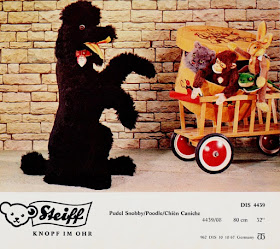Are you ready for yet(i) another Steiff treasure? This one is so unusual that its hard to believe it was really made by Steiff - but it was, and at a really challenging time in history. Take a look at this small white Teddy bear that Steiffgal recently purchased on eBay. Despite its obvious condition issues, its rarity and unusual form make it simply irresistible! Come take a look at what makes this "blizzard baby" so interesting from the design and historical perspectives.
 It is clear that Old Yeti today has a face only a mother (or a diehard Steiff collector) could love. But it was not always that way. He started out life looking like the bear pictured here on the right. The photo is from Christies, from their October 2010 Steiff sale. He is cataloged here as "A Steiff Wool Pom-Pom Teddy Bear, (5522), standing, white, brown and black glass eyes and FF button with yellow cloth tag, 1936-1938 - 9in. (23 cm.) high." The catalog also notes, "Only 955 examples of this bear were made between 1936 and 1938." This tissue-new example realized GBP 5,250 at auction.
It is clear that Old Yeti today has a face only a mother (or a diehard Steiff collector) could love. But it was not always that way. He started out life looking like the bear pictured here on the right. The photo is from Christies, from their October 2010 Steiff sale. He is cataloged here as "A Steiff Wool Pom-Pom Teddy Bear, (5522), standing, white, brown and black glass eyes and FF button with yellow cloth tag, 1936-1938 - 9in. (23 cm.) high." The catalog also notes, "Only 955 examples of this bear were made between 1936 and 1938." This tissue-new example realized GBP 5,250 at auction.
Despite old Yeti's appearance today, you can still make out some of the traditional Teddy bear features Steiff was trying to capture in this woolen miniature version. These are most prominent in the shape of his limbs. His arms do feature clearly curved wrists and suggest small hand paws. And his legs are also defined with proportional feet. These shapes are not wired and it is hard to figure out how Steiff pulled this off using pom-poms, but they did. Steiffgal suspects that the ears are mohair as they would be able to support and sustain a button-in-ear while a pom-pom version could not. You can see a close up of Old Yeti's button in ear here on the left.
Old Yeti has a great yarn to spin. He is a part of the company's long history of woolen miniature production. The very first woolies, introduced in 1931, were a series of six birds. Each was a different color and made in 4 or 8 cm. They had metal legs and feet and felt beaks and tails. They wore their buttons and earflags as tiny “ankle bracelets” around their sturdy legs. Soon after, Steiff added rabbits, cats, mice, monkeys, ducks and other animals to their line. Despite their proportions, most had jointed heads and, where appropriate, charming details that included tiny metal legs; felt beaks, wings and ears; colorful slippers; and headwear, including bonnets, top hats and lacy veils. Most of the standard line woolies were made in the 5 to 15 cm size range; this Teddy bear was among the largest if not the largest sized "miniature" produced. You can see a small collection of Steiff's prewar woolen miniature birds here on the left.
Collectors can certainly admire Steiff for trying to create a Teddy bear in the woolie style. And, given his years of production - when mohair fabrics were in short supply but wool threads less so - could understand why the company would use this type of material in its Teddy bear production strategy.
Steiffgal hope this discussion on Steiff's prewar woolen miniature bears has added a few Teddy hugs to your day.
Have a question about one of your Steiff treasures? Let's talk! Click here to learn more.














